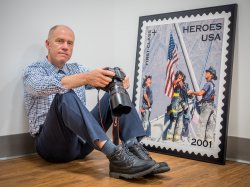Faculty Spotlight: Professor Thomas Franklin
Empowering Tomorrow’s Visual Communicators
Posted in: School of Communication and Media News

The first week of classes this semester, Professor Thomas Franklin played a video for his Multimedia News Production and Media Tech Toolkit classes that depicted the undertaking of covering the events of 9/11 as a news event and the making of the famous photograph that captured the American spirit emerging on a dark day in history. This image, showing 3 firemen raising the American flag at ground zero, just happens to be one of Franklin’s many ground breaking creative works that have proven images not only tell our stories, but have the power to improve and shape our lives. Franklin is now helping to shape the lives of students at Montclair State University as one of the newest professors of the School of Communication and Media and it is this underscored lesson he hopes to instill.
“There’s a whole world of stories out there waiting to be told and I hope that they [students] dream big and try to become tomorrow’s journalists,” said Franklin. “To use all this great technology that’s at our disposal to do it better than the previous generation.”
Franklin, still a working journalist, has a plethora of journalistic mastery resting at his fingertips to pass on to today’s fresh generation of storytellers. Not only is Franklin a Pulitzer Prize finalist for his 9/11 photo, but he has also received accolades for his “Toxic Legacy” documentary for NorthJersey.com, The Record of Bergen County, in the mid 2000s. As another groundbreaking work, the Toxic Legacy project produced reporting that lead to the only time in history that the US Environmental Protection Agency (EPA) has re-designated an area as a superfund site. This event resulted from team investigative work concerning toxic waste dumping by the Ford Motor Company in the 1960’s on tribal land and sources of drinking water in the foothills of the Ramapo Mountains.
Keeping with his desire to teach the impact of telling stories through images, Franklin conducts speaking engagements at schools and organizations to relay his personalized message about the principles and power of visual communication. Evidently, Franklin has not been content to keep his talents to himself. He has also been teaching for the past 11 years as an adjunct professor at Ramapo College. Now, Franklin is eager for his new venture as an assistant professor at Montclair State.
“I was really ready for a new challenge and I like teaching, I like working with people who are trying to learn the skills of visual communication,” said Franklin. “I saw a lot of things happening here at Montclair such as a new journalism major and a new school of communication building being built.”
Franklin sees great potential for his work at Montclair State and its applications for the future of journalism.
“It’s an exciting time,” said Franklin. “…The idea of working with tomorrow journalists is very exciting.”
In Franklin’s classes, tomorrow’s journalists are gaining a true to life, practical knowledge of the impactful outreach of journalistic artistry. Franklin’s 9/11 photo is a living example of the power of the picture and visual communication overall.
“I think photography’s a very powerful tool, powerful medium, so is video,” said Franklin. “But, if you were to talk about this photograph [“Rising the Flag at Ground Zero”], here we are 14 years later and I still get letters, emails, or phone calls from people reaching out to me to tell me how much the picture means to them. The fact that a photograph can resonate with people after all this time really speaks to the power of photography.”
The 9/11 photo had such an impact that it became a semi postal stamp with proceeds going towards the families of the victims of 9/11. The “Heroes of 2001” stamp raised over 10 million dollars, more than could be allocated, which allowed for some of the funds to be disbursed to the victims of Hurricane Katrina through the Federal Emergency Management Agency (FEMA).
“Here you have two disasters, two national tragedies that were helped in a small way by the power of this picture,” said Franklin.
The message of this power and application is at the very essence of Franklin’s engagement with students. Recently, Franklin enlisted former Record colleague and NY Daily News reporter, Michael Feeney, to impart additional insights to his Writing to Media class, even inviting other professors and communication classes to reap in the benefits. What’s more, Franklin’s Multimedia News Production class has had their own hand in legendary journalistic art, as they have created an audio slideshow on Montclair’s Yogi Berra Museum and the life of the iconic Yankees catcher. Franklin strives to convey the creativity and strategy behind building a visually communicative work to challenge students to speak volumes without words and grasp hearts at a distance.
“We definitely want them thinking critically,” said Franklin. “We’re teaching them skills and we’re teaching them strategies and it’s now up to them to take what they’ve learned and tell stories in effective ways, maybe in different ways.”
Franklin hopes to encourage students to take the skills afforded them with an understanding of the transformative capability they possess. One thing is very clear, Franklin’s stories continue to impact, now intertwining in the fabric of his Montclair State University student’s stories and re-emerging as a blank canvas poised for the youthful artistry to come. We need only wait and see.
